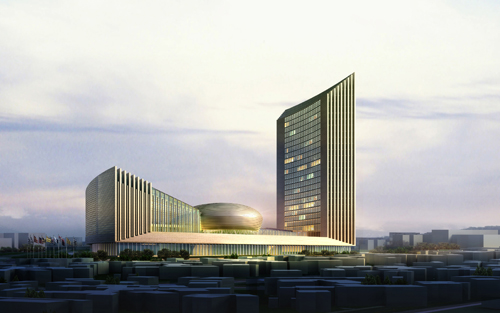|
|

|
|
STANDING TALL:The new AU headquarters is the symbol of Africa's unity (COURTESY PHOTO) |
Aschelew Tdsse, an Ethiopian construction contractor, is looking up at a new 20-story building with pride. The recently completed structure is now home base for the African Union (AU). Tdsse has worked on its construction in Addis Ababa since 2009.
"We worked very efficiently and at a fast pace," he said. "The whole project was running like a Boeing 787 airplane." Tdsse is just one of many local workers who partnered with the China State Construction Engineering Corp. to get the building site up and running in the Ethiopian capital. Despite some early communication issues with Chinese colleagues, he noted it was a valuable experience. "I am proud to see African leaders [will be] assembling here."
The new AU headquarters, located just adjacent to its previous address, has both a separate conference center with seating capacity for 2,505 and another sub-conference building with 31 meeting rooms. The total area of the complex is 112,000 square meters.
At 99.9 meters high, the main building commemorates the AU's founding date of September 9, 1999, signifying the rise of the African continent.
Investment in the headquarters construction totaled 800 million yuan($123.7 million). It marks the biggest Chinese aid project in Africa since the Tanzam Railway was built in the 1970s.
"It's a new milestone in the development of Sino-African relations," said Ambassador John Kayode Shinkaiye. He is chief of staff to the Bureau of the Chairperson at the AU Commission.
With 54 member states, the AU plays an important role in conflict mediation and maintaining regional security. Yet, it has operated without a permanent base for a long time. The new headquarters are meant to remedy this situation.
Project challenges
The complex's construction was one of the eight measures promised by Chinese President Hu Jintao during the Beijing Summit of the Forum on China-Africa Cooperation (FOCAC) held in Beijing in 2006. The aid project was meant to demonstrate China's support for African unity and integration.
This promise, in turn, brought more pressures on the China State Construction Engineering Corp., which was in charge of the project. With its new responsibilities, the firm had to adhere to higher quality standards.
"It's both a national mission and an honor for our company," said Song Sudong, who oversaw the company's China Technical Team of Senior Engineers. "For me personally, I feel I shoulder a heavy responsibility in terms of the scale, the complexity and the design of the project, as well as the people involved. But I like challenges."
The headquarters' multi-arc design created difficulties during the construction. It required precise dimensions, and the materials were special-customized and ordered after careful calculation in China. They were installed on-site after being shipped. Good planning was key, since it took months for materials to be delivered by sea and land transport.
|